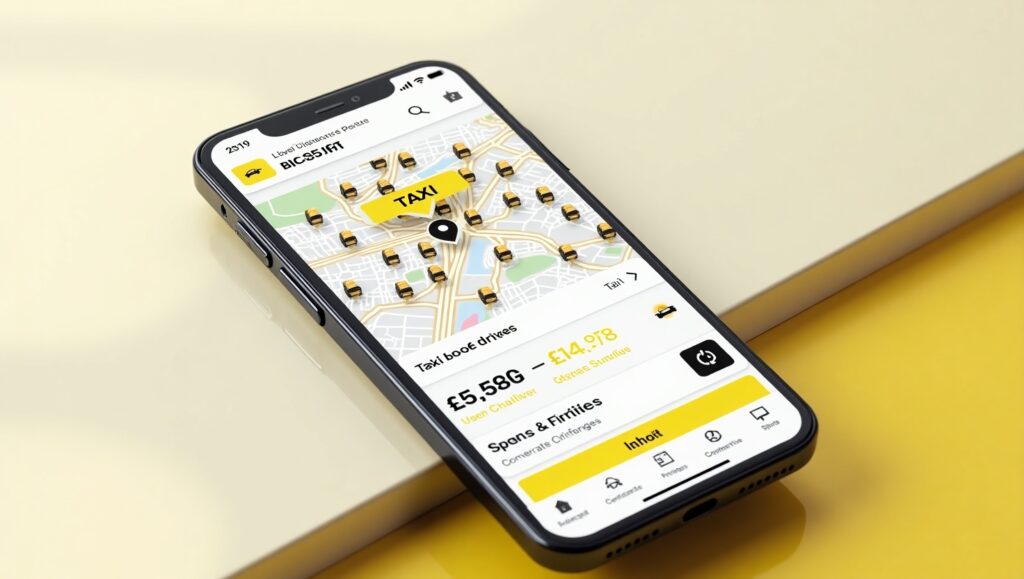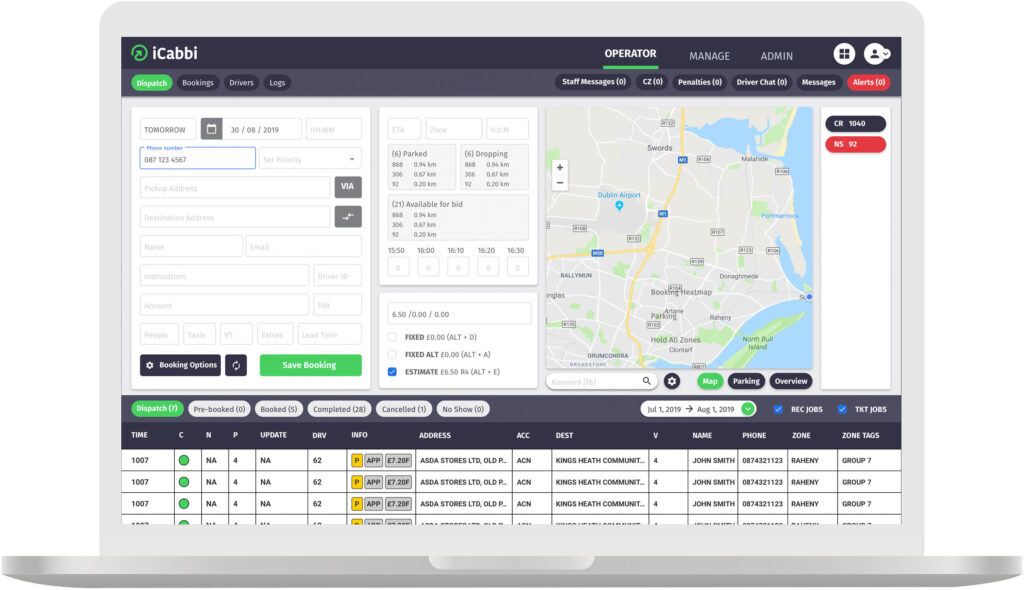In today’s fast-paced urban landscape, where every minute counts, taxi dispatch services have transcended their original role as mere logistical tools to become the beating heart of urban mobility. At GN Technologies, we specialize in taxi dispatch services designed for efficiency and seamless operations. What began as rudimentary radio-based systems has evolved into intricate, AI-driven networks that power efficient, reliable, and dynamic transportation. As traditional taxi firms adapt to the digital revolution, these systems have not only redefined how we move through cities but have also ushered in a new era of customer experience, operational excellence, and competitive innovation.
Table of Contents
A Journey Through Time: The Evolution of Taxi Dispatch
From Radio Waves to Digital Highways
For decades, taxi dispatch systems relied on the humble radio—a tool that, while revolutionary in its time, was fraught with limitations. Dispatchers manually connected passengers with drivers using two-way radios, a method that was prone to miscommunication, delays, and inefficient allocation of resources. These early systems, though innovative for their era, often left drivers waiting for long periods and passengers stranded in uncertainty.
The turn of the millennium marked a pivotal moment as digital communication began to take center stage. The integration of telephone networks, computer-aided dispatch (CAD) systems, and later, mobile technology, transformed taxi dispatch operations. These innovations enabled real-time communication, streamlined ride assignments, and improved the overall responsiveness of taxi fleets.

The Digital Dispatch Revolution
The emergence of computer-aided dispatch systems brought forth a paradigm shift. By automating many of the dispatch processes, these systems drastically reduced human error and improved operational efficiency. Dispatchers could now track the exact location of each vehicle, ensuring that the nearest available taxi was sent to a customer in need. This digital transformation laid the groundwork for what would soon become a fully app-based ecosystem.
Advancements in GPS and mobile connectivity meant that drivers could be tracked with pinpoint accuracy, and routes could be optimized to avoid congested areas. This not only reduced waiting times for passengers but also minimized fuel consumption and wear and tear on vehicles. The early stages of this revolution set the stage for what many now recognize as the ride-hailing revolution.
App-Based Ride-Hailing: Disrupting the Norm
The advent of ride-hailing apps like Uber, Lyft, and Bolt redefined the concept of taxi dispatch. With just a few taps on a smartphone, users could summon a ride, track its progress in real time, and even pay digitally—all without the need for human intervention. This seamless integration of technology into daily commuting reimagined what taxi services could offer.
These platforms introduced dynamic pricing models that fluctuated based on demand, ensuring that supply met customer needs even during peak hours or in underserved areas. Moreover, the incorporation of customer reviews and driver ratings created a feedback loop that continually enhanced service quality. For traditional taxi companies, this digital onslaught presented both a challenge and an opportunity: innovate or risk obsolescence.
The Anatomy of a Modern Taxi Dispatch System
Key Components and Features
Modern taxi dispatch systems are a complex interplay of hardware, software, and human oversight. At their core, they integrate several critical components:
- Cloud-Based Platforms: By migrating dispatch operations to the cloud, taxi companies can centralize data, enable real-time updates, and scale operations without significant capital investments in physical infrastructure. Cloud computing has not only reduced costs but also enhanced system reliability and security.
- AI-Powered Algorithms: The application of artificial intelligence has been a game changer. AI algorithms analyze traffic patterns, predict demand surges, and optimize routing to ensure that the right taxi is dispatched at the right time. These systems learn from historical data to continuously refine their predictions, leading to faster response times and improved service reliability.
- GPS Tracking and Real-Time Navigation: Accurate location tracking is indispensable in a modern taxi dispatch system. Real-time GPS not only facilitates efficient ride allocation but also assists drivers in navigating urban mazes, circumventing roadblocks, and arriving at destinations promptly.

- Multi-Platform Accessibility: Today’s consumers demand convenience. As a result, dispatch systems are designed to be accessible through various channels—mobile apps, web interfaces, and even traditional call centers—ensuring that customers can book rides in the manner most convenient to them.
- Integrated Payment Solutions: Seamless integration with payment gateways such as Stripe, PayPal, Apple Pay, and Google Wallet has revolutionized fare collection. Automated fare calculations, digital receipts, and cashless transactions have not only simplified payments but also enhanced transparency for both drivers and passengers.
- Data Analytics and Reporting: Robust data analytics tools allow taxi companies to monitor performance metrics ranging from ride frequency and peak hours to driver efficiency and revenue generation. These insights drive strategic decision-making and enable continuous operational improvements.
How It Works: The Step-by-Step Process
A modern taxi dispatch process unfolds in several coordinated steps:
- Customer Initiation: The process begins when a customer requests a ride via a mobile app, website, or even through a traditional phone call. The system then captures essential details such as pickup location, destination, and preferred ride type.
- Smart Matching: Leveraging AI, the dispatch system identifies the closest available driver. This matching process considers several variables including driver location, current traffic conditions, and historical response times to ensure that the allocation is both efficient and cost-effective.
- Driver Notification: Once a match is found, the driver receives a detailed notification on their device, complete with the customer’s location, estimated fare, and destination details. This automated communication minimizes the need for manual intervention and speeds up the overall process.
- Ride Execution: As the driver navigates to the pickup location using real-time GPS navigation, the customer can track the ride’s progress on their app. This transparency builds trust and reduces uncertainty, especially during peak hours or in unfamiliar neighborhoods.
- Seamless Payment: After the ride, the system automatically calculates the fare based on distance, time, and dynamic pricing factors. Payments are processed digitally, with detailed invoices sent to the customer, ensuring complete transparency and record-keeping.
- Feedback Loop: Finally, a post-ride feedback mechanism allows customers to rate their experience. This feedback is invaluable for continuous service improvement, helping taxi companies address any issues and maintain high standards.
The Multifaceted Benefits of Modern Taxi Dispatch Systems
Enhancing Operational Efficiency
One of the most significant advantages of modern dispatch systems is the dramatic boost in operational efficiency. By automating ride allocation, taxi companies can reduce idle times, ensuring that drivers spend more time on the road and less time waiting for assignments. This not only increases the number of rides completed per day but also maximizes revenue potential for both drivers and companies.

Optimized Routing:
AI-powered routing solutions analyze real-time traffic data to suggest the fastest routes. This optimization not only saves time but also reduces fuel consumption and vehicle maintenance costs.
Increased Productivity:
The integration of cloud-based platforms allows for centralized management of multiple fleets across different locations. This consolidation streamlines operations, making it easier to manage large fleets and scale operations efficiently.
Revolutionizing the Passenger Experience
For passengers, modern taxi dispatch systems have redefined convenience and reliability. No longer must riders worry about long wait times or unclear fare structures. Instead, they benefit from a seamless, transparent, and efficient service.
Real-Time Tracking:
Passengers can monitor the progress of their taxi in real time, reducing the anxiety of waiting in the cold or on a busy street. This feature, combined with precise pickup estimates, enhances the overall travel experience.
Transparent Pricing:
Dynamic pricing models and automated fare calculations provide passengers with clear, upfront cost estimates. This transparency builds trust and encourages repeat usage, as riders know exactly what to expect.
Enhanced Safety:
Modern systems incorporate numerous safety features, from in-app emergency buttons to real-time location sharing with friends or family. These measures have significantly increased passenger confidence, particularly for rides during off-peak hours.
Benefits for Taxi Drivers and Fleet Operators
Taxi dispatch systems are equally transformative for drivers and fleet operators, offering a suite of benefits that improve their day-to-day operations.
Optimized Earnings:
By reducing downtime and ensuring that the nearest driver is dispatched, these systems maximize the number of rides a driver can complete. In turn, this translates to increased earnings and a more predictable income stream.
Data-Driven Decision Making:
Fleet operators gain access to a wealth of data—ranging from ride patterns to driver performance metrics. These insights allow for informed decisions regarding fleet expansion, route optimization, and even driver training programs.
Enhanced Communication:
Automated notifications and real-time updates streamline communication between drivers and dispatchers. This clarity reduces miscommunication and ensures that drivers are always informed of the best routes and potential traffic issues.
Overcoming Challenges in the Modern Taxi Landscape
While the advantages of modern taxi dispatch systems are numerous, the industry is not without its challenges. Traditional taxi companies often find themselves pitted against agile, tech-savvy ride-hailing giants that have redefined customer expectations.
Competition with Ride-Hailing Services
The rise of companies like Uber, Lyft, and Grab has dramatically reshaped the transportation landscape. Their innovative app-based models, dynamic pricing, and flexible work arrangements have attracted a vast customer base. For traditional taxi firms, the challenge lies in adapting quickly to these new technologies without losing their core identity. While many have invested in digital dispatch solutions, the need to offer competitive pricing and exceptional service remains paramount.
For a detailed comparison between taxi firms, check out our guide on Kirkcaldy Taxis vs. Neath Taxis.

Regulatory and Licensing Complexities
Taxi dispatch services must navigate a labyrinth of local, state, and national regulations. These rules cover everything from fare structures and driver background checks to vehicle maintenance standards and insurance requirements. Compliance can be costly and time-consuming, particularly for small or mid-sized fleets. However, forward-thinking companies are finding that investing in technology not only streamlines operations but also simplifies regulatory compliance through automated record keeping and digital audits.
Cybersecurity and Data Privacy
As taxi dispatch systems increasingly rely on digital infrastructure, the risk of cyberattacks grows in tandem. Protecting sensitive data—ranging from customer payment information to driver locations—is critical. Companies must invest in robust cybersecurity measures to safeguard their systems against data breaches and other malicious threats. A single security lapse can not only damage a company’s reputation but also result in significant financial losses.
Driver Retention and Satisfaction
The gig economy has reshaped the expectations of drivers, many of whom now seek greater flexibility and higher earnings. Traditional taxi companies must balance the demands of full-time drivers with the growing trend of part-time, freelance work. Offering competitive incentives, performance bonuses, and a user-friendly digital platform can help in attracting and retaining top driving talent.
Case Studies: Traditional Taxi Firms vs. Ride-Hailing Giants
Examining real-world examples offers valuable insights into how different players in the taxi dispatch space are innovating to stay ahead.
Traditional Taxi Firms Embrace Digital Transformation
In many metropolitan areas, long-established taxi companies have started investing heavily in digital dispatch systems. For example, some fleets have transitioned from radio-based systems to integrated cloud platforms, significantly reducing response times and operational costs. These companies have also introduced mobile apps that allow passengers to book rides with the same ease as ride-hailing giants. By leveraging technology, they are not only retaining loyal customers but also appealing to younger, tech-savvy demographics.
Ride-Hailing Platforms: A New Paradigm
On the other hand, ride-hailing companies have redefined customer expectations from the ground up. With features such as real-time tracking, in-app payment systems, and dynamic pricing, these platforms offer an unmatched level of convenience. Their use of data analytics to predict demand and optimize routes has set new benchmarks for operational efficiency. Although they face their own challenges—such as regulatory scrutiny and market saturation—their innovative models continue to disrupt the industry.
The Road Ahead: Future Trends in Taxi Dispatch Services
As we look to the future, several emerging trends promise to further revolutionize taxi dispatch services. These innovations are poised to create more seamless, efficient, and sustainable transportation networks. For insights on urban mobility regulations, the U.S. Department of Transportation provides comprehensive guidelines. Additionally, detailed industry forecasts can be found through Market Research.

Autonomous Taxis and AI-Driven Dispatch
The prospect of self-driving taxis has long been a topic of science fiction, but today it is edging closer to reality. Autonomous vehicles, when paired with AI-powered dispatch systems, can drastically reduce human error and optimize route planning. Companies are already testing prototypes in select cities, and while widespread adoption may still be a few years away, the potential impact on urban mobility is immense. Autonomous taxis promise not only to cut operating costs but also to improve safety and reduce congestion by coordinating movements in real time.
Blockchain and Transparent Pricing Models
Blockchain technology offers the promise of enhanced transparency and security in fare transactions. By creating an immutable ledger of all transactions, blockchain could eliminate fare disputes and build greater trust among customers. Such technology could also be used to implement smart contracts that automatically adjust pricing based on demand, ensuring fairness for both drivers and passengers.
Integration with the Internet of Things (IoT)
The future of taxi dispatch services will likely see even deeper integration with IoT. Smart traffic systems, connected vehicles, and sensor-driven data analytics can work in concert with dispatch software to create a fully integrated transportation ecosystem. For instance, real-time data from traffic cameras and road sensors can be fed into dispatch systems to provide instant updates on road conditions, enabling more precise route adjustments and improved service delivery.
Sustainable and Eco-Friendly Fleets
With the growing global emphasis on environmental sustainability, taxi fleets are increasingly incorporating electric and hybrid vehicles. These eco-friendly options not only reduce carbon emissions but also attract environmentally conscious consumers. Modern dispatch systems are adapting to support these greener fleets by integrating data on battery life, charging station availability, and energy consumption—ensuring that sustainable transportation is not just an ideal but a practical reality.
Enhanced User Experiences through Personalization
Future taxi dispatch systems are set to leverage big data and AI to offer hyper-personalized experiences for passengers. Imagine a system that remembers your preferred routes, adjusts the ride experience based on your previous feedback, and even offers tailored promotions. This level of personalization could transform every ride into a uniquely curated experience, fostering customer loyalty and setting a new standard for service excellence.
Practical Insights: Best Practices for Modern Taxi Dispatch
For taxi companies seeking to stay competitive in this rapidly evolving landscape, several best practices have emerged:

- Invest in Scalable Technology:
Embrace cloud-based solutions that can grow with your business. Scalable systems reduce the need for costly hardware upgrades and allow for flexible management of fleets across multiple cities. - Prioritize Data Security:
Implement robust cybersecurity protocols to protect sensitive data. Regular audits, encryption, and secure payment gateways are essential to building trust with both drivers and passengers. - Enhance Driver Engagement:
Develop incentive programs and user-friendly mobile platforms that empower drivers. Providing clear communication channels and performance feedback can improve driver satisfaction and retention. - Integrate Real-Time Analytics:
Use data analytics to monitor key performance indicators. Real-time dashboards can provide insights into peak demand periods, route efficiency, and overall operational performance, enabling timely adjustments and strategic planning. - Focus on Customer Feedback:
Create mechanisms for collecting and analyzing customer feedback. This continuous loop of insights can help refine service offerings and ensure that the customer experience remains at the forefront of operational strategies.
Real-World Impact: Economic and Social Implications
Economic Benefits
The adoption of modern taxi dispatch services has far-reaching economic implications. For cities grappling with traffic congestion and pollution, efficient taxi services offer a more sustainable alternative to private vehicle ownership. Moreover, by reducing idle time and optimizing routes, taxi companies can significantly lower operational costs. This efficiency not only boosts profits but also has the potential to lower ride costs, making urban transportation more accessible to a broader population.
Social Benefits
From a social perspective, enhanced taxi dispatch services contribute to safer and more reliable urban mobility. Real-time tracking and rapid response capabilities reduce the risk of passengers waiting in unsafe conditions. Additionally, the transparency offered by modern payment systems builds trust—a critical factor in fostering a positive relationship between service providers and the communities they serve.
Urban Planning and Infrastructure
As taxi dispatch services evolve, they increasingly influence urban planning. Data-driven insights from dispatch systems can help city planners identify traffic bottlenecks and design more efficient transportation networks. This collaboration between private industry and public infrastructure paves the way for smarter, more resilient cities.
Embracing Change: The Cultural Shift in Urban Mobility
The transformation of taxi dispatch services is not just about technology—it’s about a cultural shift in how we view urban transportation. The traditional image of a lone taxi cruising empty streets has given way to a sophisticated, interconnected network that offers reliability, convenience, and safety. This cultural shift is driven by changing consumer expectations and a broader societal move toward digital, on-demand services.
As riders increasingly demand efficiency and transparency, taxi companies are forced to innovate at a rapid pace. This innovation is not only technological but also operational. It requires a fundamental rethinking of business models, customer service strategies, and even the role of human drivers in an increasingly automated world.

Conclusion: Navigating the Road Ahead
The evolution of taxi dispatch services is a testament to the transformative power of technology. From humble radio dispatch systems to cutting-edge AI platforms, the journey has been marked by innovation, adaptation, and relentless pursuit of efficiency. Today, taxi dispatch systems stand as a critical pillar of urban mobility—optimizing operations, enhancing customer experiences, and paving the way for a more connected, sustainable future.
As we navigate this rapidly changing landscape, the road ahead is clear: taxi companies that invest in modern dispatch technologies will not only survive but thrive in the digital age. Embracing the benefits of AI, blockchain, IoT, and autonomous vehicles will redefine urban transportation, offering unprecedented levels of service, reliability, and convenience.
For industry veterans and new entrants alike, the challenge is to harness these technological advancements while staying true to the core mission of providing safe, reliable, and accessible transportation for all. The fusion of tradition and innovation in taxi dispatch services is setting the stage for a new era of mobility—one that promises to transform our cities and the way we move within them.
In a world where every second counts, taxi dispatch services have proven to be much more than a logistical necessity. They are a catalyst for change—driving efficiency, empowering drivers, and ensuring that urban mobility meets the demands of a modern, digital society. Whether through enhanced safety features, intelligent routing, or the integration of sustainable practices, the future of taxi dispatch is as bright as it is dynamic.
By embracing these changes and continuously pushing the boundaries of what is possible, the taxi industry is not just keeping pace with the digital revolution—it is leading the charge. As urban landscapes continue to evolve, so too will the systems that power our journeys, ensuring that the ride is always smooth, safe, and smart.
The road ahead is full of promise, and for those willing to innovate and adapt, the journey is just beginning. Welcome to the future of urban transportation—a future where technology and human ingenuity come together to create a smarter, more connected world. Looking for a custom dispatch solution? Explore our B2B taxi dispatch services designed for taxi firms and fleets.
Interested in optimizing your taxi business? Contact GN Technologies today to discuss tailored dispatch solutions!



